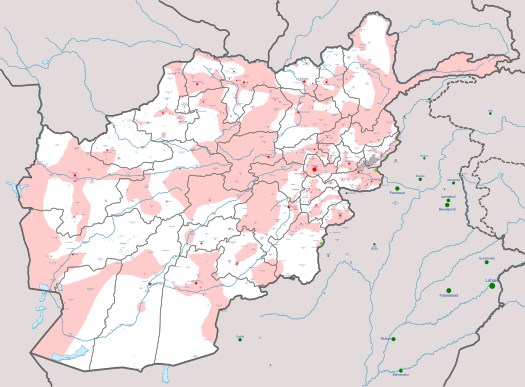US and Allied troops to withdraw from Afghanistan by September 11, 2021

Afghan territorial lines as of April, 2021. Red is under Afghan Government/Coalition control, white under the Taliban.
April 22, 2021
On April 14th, the White House announced that all American service members shall be out of Afghanistan by September 11th, 2021, 20 years to the day after the terrorist attacks that ignited the global War on Terror, and instigated the invasion of Afghanistan in October of 2001. In his remarks from the Roosevelt Room, President Biden stated that “our presence in Afghanistan should be focused on the reason we went in the first place: to ensure Afghanistan would not be used as a base from which to attack our homeland again. We did that. We accomplished that objective.” He laid the responsibility of preserving and protecting the Afghan state and civil liberties at the people of Afghanistan. According to several news outlets, the armed forces of NATO and non-NATO allies will be following the US out by the deadline set by the President.
The United States launched the invasion of Afghanistan after al-Qaeda hijackers took over passenger airliners and flew them into the World Trade Center and the Pentagon. A fourth plane was taken over and meant for a fourth target in Washington, but a revolt by passengers forced it into a field in Pennsylvania that averted casualties beyond anyone onboard. There were 2,977 innocent deaths that day. When the rulers of Afghanistan refused to extradite the al-Qaeda masterminds of the attack, the US launched an invasion to oust the Taliban from power. Osama bin Laden—and many of his followers—escaped, and regrouped in Pakistan. He was killed in a raid by Navy SEALs in Pakistan in 2011. Since the Taliban’s fall from power, they have been waging a twenty-year insurgency against the government and allied forces to reclaim lost territory in rural provinces across the country.
In his remarks, President Biden emphasized the growing threat—and number of actors—of insurgency, terrorism, and crimes against humanity occurring in the Middle East, North Africa, and other hot regions around the world. “With the terror threat now in many places, keeping thousands of troops grounded and concentrated in just one country at a cost of billions each year makes little sense to me and to our leaders. We cannot continue the cycle of extending or expanding our military presence in Afghanistan, hoping to create ideal conditions for the withdrawal, and expecting a different result.”
In negotiations with representatives of the Taliban in Qatar in 2020, the Trump Administration committed the United States to a withdrawal from Afghanistan by May 1st of 2021. President Biden’s announcement made that date the beginning of the phasing out of remaining US and allied service members from the country. According to the official NATO website, there were approximately 2500 members of the US Armed Forces in Afghanistan in February of 2021. There were an additional 7,092 service members from NATO and non-NATO allies, as well.
President Biden made clear his desire to end the “forever war”, and made clear that the US had achieved its objectives of rooting out the bulk of al-Qaeda and its leadership from Afghanistan. According to a March 2021 report by the Council on Foreign Relations, the Taliban are still likely to forge ahead with overthrowing the government in Kabul, and reestablishing Afghanistan as the Islamist emirate it was before the US-led invasion.
Over 3,000 coalition personnel have been killed in Afghanistan since the invasion. In September of 2020, the Watson Institute of International and Public Affairs at Brown University projected more than 310,000 civilian deaths.






